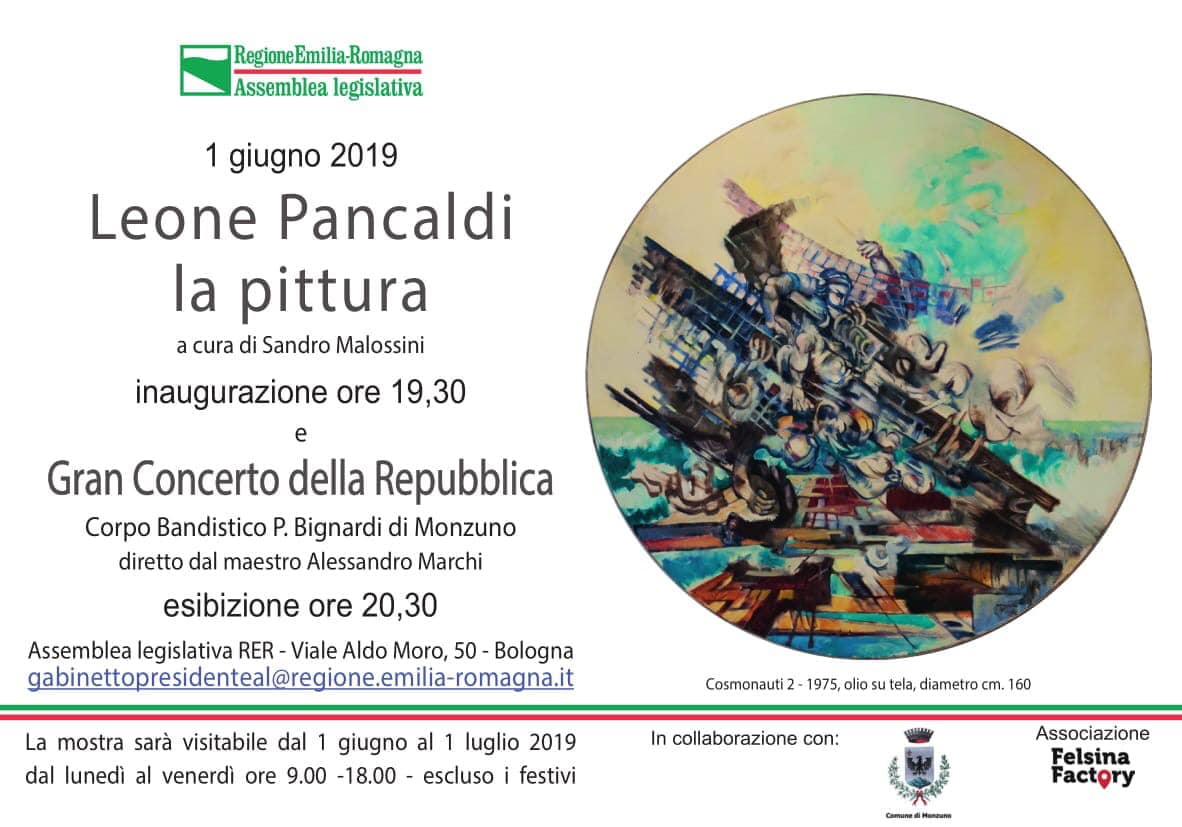A project aimed at collecting and circulating information on the life and work of Leone Pancaldi (1915-1995), Italian architect and painter

Leone Pancaldi, “Astronauts”, 1975

Leone Pancaldi in 1992
Leone Pancaldi was trained at the Academy of Fine Arts, Bologna, Italy, in the 1930s. Still a teenager, he apprenticed as a designer in technical and architects' firms. On leaving the Accademia, he taught painting in a private school of fine arts. He subsequently enrolled as a part-time student in the School of Architecture, University of Florence, where he graduated under the supervision of Adalberto Libera, a well-known representative of “rationalist” or “modern” architecture in Italy. A conscript during the second World War, he was made a prisoner by the Germans when Italy withdrew from its alliance with Hitler, and was sent to several concentration camps in succession: Oberlangen, Sandbostel, Wietzendorf... As prisoner N. 114402 he managed to keep an interest in architecture alive, as shown by a number of drawings that have survived:

Leone Pancaldi, “Ritrovo estivo”, 1944
In concentration camps he became acquainted with a number of Italian artists and intellectuals — 600,000 Italians were made prisoners by the Germans after 8 September 1943, and 40,000 did not survive. Among the new acquaintances was art and literary critic Luigi Carluccio, who took this sketch of Leone Pancaldi as a prisoner:

Leone Pancaldi in 1944, sketch by Luigi Carluccio
Back in Bologna in the summer of 1945, Leone Pancaldi resumed teaching as well as painting, and joined in the local efforts at reconstruction. The latter included a number of exhibitions of fine arts, organized by art historian and critic Cesare Gnudi, aimed at a new appraisal of the conspicuous fine-arts tradition that had characterized Bologna and its region since the 17th century. The exhibitions, and teamwork with Cesare Gnudi and Andrea Emiliani, turned Leone Pancaldi into one of the best-known architects of museums in Italy, at a time when another architect in the same field, Carlo Scarpa, was gaining international renown for Italian architects. In subsequent years the renovation of the Pinacoteca Nazionale of Bologna gave Leone Pancaldi additional fame as an architect of museums.

Leone Pancaldi, architect, L'Etruria padana exhibition, Bologna 1960

Leone Pancaldi, Pinacoteca Nazionale, Bologna, 1960, photo P. Monti

Leone Pancaldi, Pinacoteca Nazionale, Bologna, 1960, photo P. Monti

Leone Pancaldi, Pinacoteca Nazionale, Bologna, 1960, photo P. Monti
In 1968 the Museum of Modern Art (MOMA, New York) invited Leone Pancaldi and Carlo Scarpa to represent Italian architects at an exhibition focusing on “The architecture of museums”. The following year, writing for the Burlington Magazine, Donald Posner remarked that the Bologna Pinacoteca „has become, in recent years, under the inspired leadership of Cesare Gnudi and his collaboratrs, one of the most attractive museums in Italy and a world leader in the craft of museology ... Recent renovations and additions by Leone Pancaldi, an architect of great sensitivity, have transformed it into a brightly lit, extremely pleasant modern gallery that yet preserves the dignity and solidity of the old Pinacoteca.“

Cesare Gnudi and Leone Pancaldi (right), 1970, photo W. Breveglieri
In the meantime, Leone Pancaldi participated as a painter in Venice Biennale for 1956 and 1964.

Leone Pancaldi, “Ritmo”, 1955, Venice Biennale 1956
In the 1970s and 1980s Leone Pancaldi, as an architect, realized several public buildings in Bologna. The best known is the Modern Art Gallery (GAM), inaugurated in 1975.
Leone Pancaldi, Modern Art Gallery (GAM), Bologna, 1975

Leone Pancaldi, Modern Art Gallery (GAM), Bologna, 1975, interior
Another is the building for the Regione Emilia-Romagna:
Leone Pancaldi, building for the Regione Emilia-Romagna, 1969-1975
Leone Pancaldi's production as an architect included a building for IBM, and several private houses.
Leone Pancaldi, IBM building, Borgo Panigale, Bologna, 1976-79

Leone Pancaldi, sketch of a villa on the hills near Bologna, 1970s

Leone Pancaldi, house in Monte Calvo, Bologna, 1970s

Leone Pancaldi, “Omaggio a Géricault”, 1973
Leone Pancaldi's work as a painter continued into the 1990s. When he died, in 1995, he left about 300 paintings and a rich archive illustrating his work as an architect.G. Pancaldi with V. Pancaldi









 Corriere di Bologna,
Corriere di Bologna,